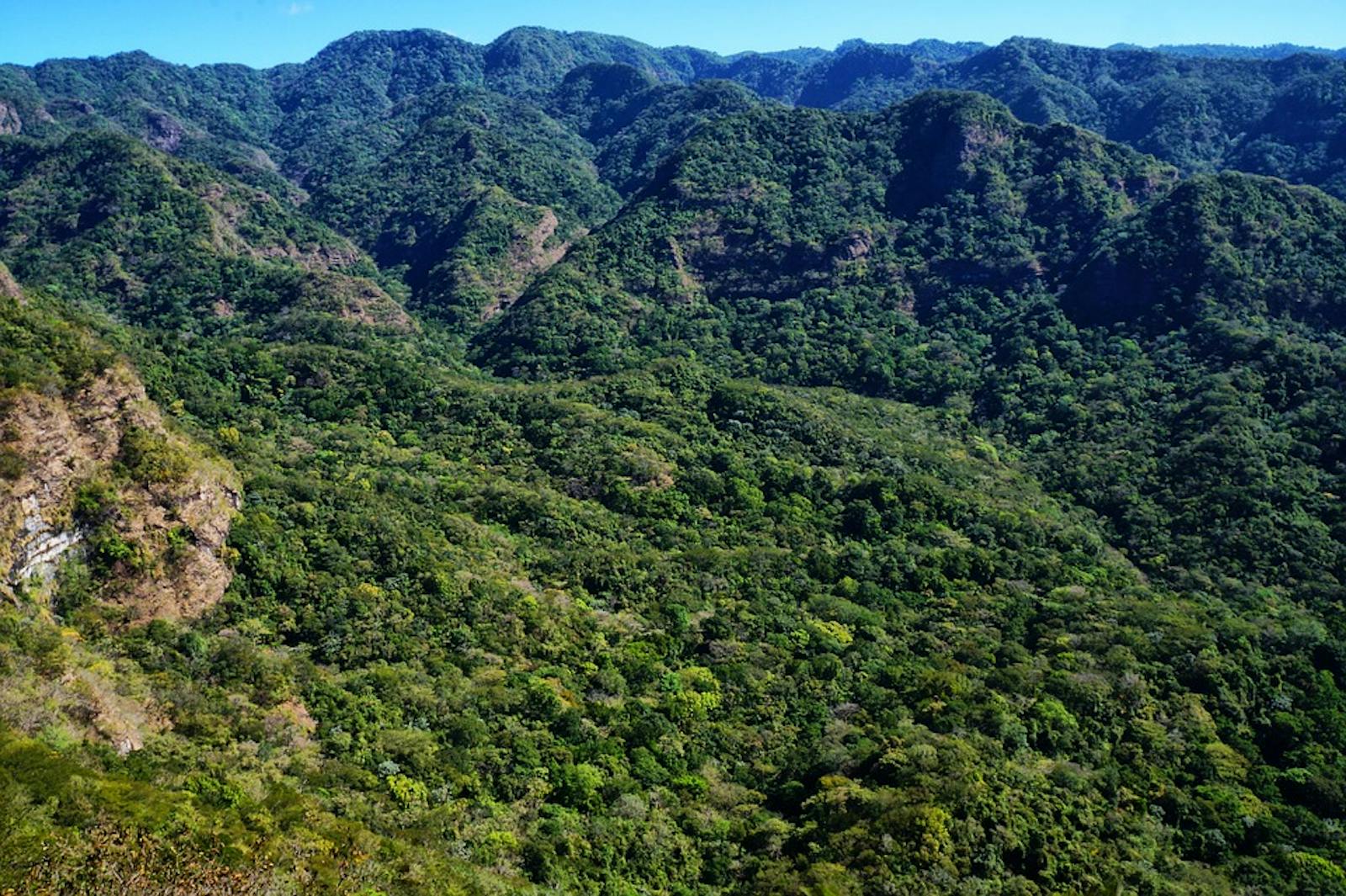Central American Montane Forests
The ecoregion’s land area is provided in units of 1,000 hectares. The protection goal is the Global Safety Net (GSN1) area for the given ecoregion. The protection level indicates the percentage of the GSN goal that is currently protected on a scale of 0-10.
Bioregion: Central American Mixed Forests (NT25)
Realm: Central America
Ecoregion Size (1000 ha):
1,333
Ecoregion ID:
451
Conservation Target:
86%
Protection Level:
4
States: Guatemala, Honduras, El Salvador, Nicaragua
The horned guan is a large turkey-like bird restricted to the mountain top cloud-forest “archipelagos” in the Sierra Madre de Chiapas, Mexico, and western Guatemala. It is distinguished from all other guan species by its white belly and large red “horn”. Larger than almost any other birds in the cloud-forest, its flapping wings can be heard when they fly between the low branches of oak trees.
They spend the winter months during their nesting season attending their eggs and chicks to protect them against predators, who can easily access the nests in the low branches. Little is known about these large Cracids—the family to which chick guan, chacalaca, and curassow all belong—but they are suspected to migrate altitudinally along the mountain slopes to follow the fruiting seasons of their favorite fruit trees.
The Central American Montane Forests ecoregion comprised of more than 40 relatively small islands extending from southern Mexico towards the southeast through Guatemala, El Salvador, Honduras, and Nicaragua. The generally widely scattered mountains rise out of largely pine-oak forest and make up only about 10 percent of the total area. They range in size from a single massif of 2,000 km2 on the border between Mexico and Guatemala to small isolated mountains of less than 1 km2 in southern Honduras and western El Salvador. Maximum elevations of these habitat islands vary in elevation from 1,500 to 4,000 m.
.jpg)
The flagship species of the Central American Montane Forests ecoregion is the horned guan. Image credit: Salomongp, Creative Commons
Rainfall is typically heavy with 2,000 to 4,000 mm falling annually. The vegetation is a mix of northern and southern elements combined with high endemism, reaching up to 70 percent on the larger islands. These mountains are essentially the southern limits for the distributions of conifers such as Abies, Juniperus, Cupressus, and Taxus, which tend to grow on the wetter, north-facing slopes near the tops of the higher mountains.
There are 13 species in total and virtually all terminate their southern extensions in this ecoregion and the surrounding pine-oak forest. These conifers are interspaced with more classical broadleaved evergreen forests that are dominated by oaks (Quercus). Intermixed with these genera of northern origin are genera such as Persia (Lauraceae) and the endemic agave in Guatemala, both associated with southern tropical habitats.
As with other mountain ranges in tropical America, migration is an important ecological process. This ecoregion is characterized by both local migrations and inter-continental migrations of birds and butterflies between Central America and North America. More than 20 bird species that breed in North America spend their winters in Central American Montane Forests habitats. Endemic species include the horned guan and the subspecies of the resplendent quetzal, Pharomacrus mocinno mocinno.
Most of the higher elevations of the mountains of Central America have been declared as protected areas, although enforcement or even infrastructure is missing in most cases. Honduras has declared that all land over 1,800 m is to be protected, but only 10 of at least 32 declared areas have been mapped or have conservation-related infrastructure. Similarly, El Salvador has very few areas actively protected.
Protected areas in both countries are small and unlikely to conserve their biodiversity if they are not expanded significantly. In Guatemala, the largest block of intact habitat is Sierra de las Minas, about 2,000 km2, probably the only protected area in the ecoregion that has the potential to maintain its full complement of biodiversity and ecological processes. Beyond this reserve, the government maintains the small Quetzal Biotope; the indigenous communities situated around the Pacific Rim volcanoes adjacent to Lake Atitlan also have small community reserves on these mountains.
The upper reaches of the mountains are typically inhospitable to human activities and are therefore still largely intact. Development pressures are increasing as the primarily indigenous population outgrows its traditional agricultural base of corn cultivation in the surrounding pine-oak habitat and expands into areas that are ultimately unsustainable. The lower slopes of this montane ecoregion have already been heavily modified for cash crops such as coffee, ranching for beef, subsistence agriculture—particularly corn and beans—as well as for fuelwood. The increasing loss of the lower slopes of these mountains further fragment and isolate the already small-sized habitats from those on other mountains.
The priority conservation actions for the next decade will be to: 1) fund conservation enforcement measures in protected areas; 2) extend protected area boundaries to include Key Biodiversity Areas; and 3) incentivize and promote sustainable farming practices such as shade grown coffee.
Citations
1. Powell, G., S. Palminteri. 2018. Central America: southern Mexico, through Guatemala, El Salvador, and Honduras into northern Nicaragua. https://www.worldwildlife.org/ecoregions/nt0112 Accessed July 9, 2018.
2. Reyes Chirinos, J. and G.A. Cruz. 1994. El Sistema Nacional de Areas Protegidas de Honduras. In A. Vega (editor), Corredores Conservacionistas en la Región Centroamericana: Memorias de una Conferencia Regional auspiciada por el Proyecto Paseo Pantera. Tropical Research and Development, Inc. Florida.
3. Dix, M.A. 1997. Sierra de las Minas Region and Biosphere Reserve, Guatemala. In WWF and IUCN, Centres of plant diversity. A guide and strategy for their conservation.



